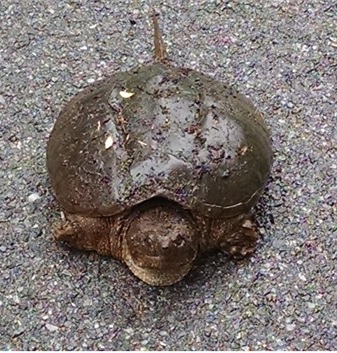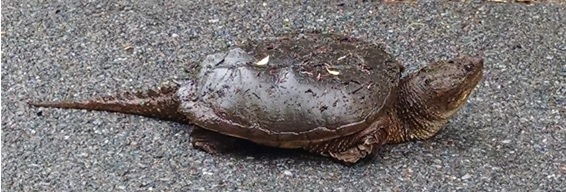 The common snapping turtle (Cheelydra serpentina) was adopted as the State Reptile of New York in 2006. The snapping turtle has a relatively small shell that does not cover its limbs or tail (snapping turtles cannot retract their heads under the shell). Color varies from light green and brown shades to very dark green and brown. Only the snapping turtle and the painted turtle are really common across New York. Snappers are the largest New York freshwater turtle, reaching shell lengths of 19 inches and weights of 70 pounds.
The common snapping turtle (Cheelydra serpentina) was adopted as the State Reptile of New York in 2006. The snapping turtle has a relatively small shell that does not cover its limbs or tail (snapping turtles cannot retract their heads under the shell). Color varies from light green and brown shades to very dark green and brown. Only the snapping turtle and the painted turtle are really common across New York. Snappers are the largest New York freshwater turtle, reaching shell lengths of 19 inches and weights of 70 pounds.
Largely nocturnal, the snapping turtle is omnivorous – about a third of its diet consist of plants, but snapping turtles are also aggressive predators, lying in wait to ambush prey. Snapping turtles have a hooked beak which can slice through the flesh and bones of its prey (small aquatic invertebrates, crayfish, snails, fish, frogs, toads, snakes, bird eggs, small mammals, carrion, and waterbirds). Snapping turtles are the stuff of legends. Their ability to damage fingers and broomsticks is greatly exaggerated, but they can deliver a painful bite. They mostly eat dead plant and animal matter, and only rarely eat unsuspecting ducklings. Their impact on fishing is often greatly exaggerated. Snapping turtles tend to avoid humans and are not considered a threat to swimmers.
Snapping turtles can live up to 60 years and are sometimes feared because of their fierce, menacing appearance. They play an important ecological role in lakes, ponds, marshes, and slow-moving streams. Female snapping turtles can journey 10 miles to reach their traditional nesting area. They don’t nest until they are about 10 years old, and only lay one set of eggs a season. Most people only see snapping turtles when the females leave the water in early summer to locate their nesting sites, where they lay between 20 and 80 ping-pong ball-shaped eggs. Many hatchlings fall prey to raccoons, skunks, snakes, bullfrogs, herons, and other large birds. Unfortunately, many of the pregnant females are hit by cars when crossing roads to reach their nesting sites. Please be alert when driving around our lakes in the spring, as each nesting female is important to the future turtle population.
Ron Tetelman reports that the same snapping turtle with a brass “number 9” tag on her shell visited his property to lay eggs for 15 years.

